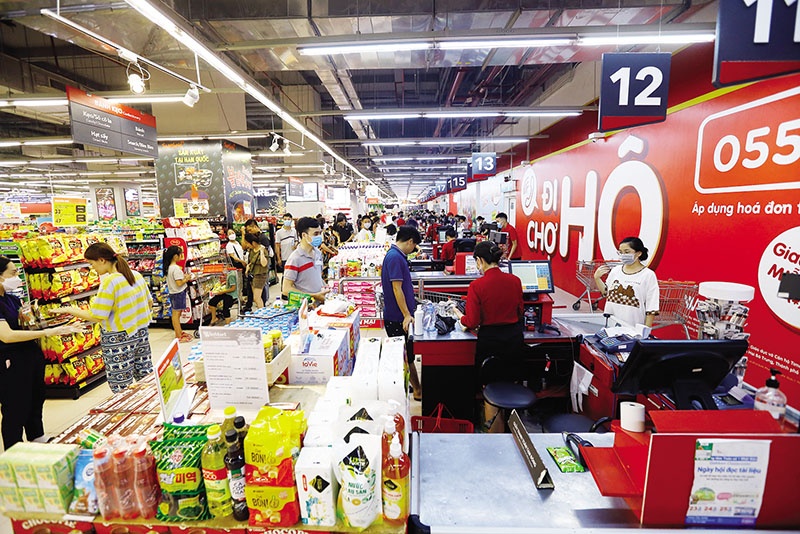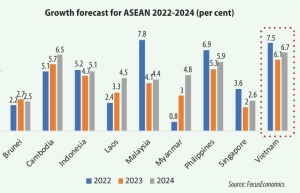2023 faces many inflationary pressures
In recent years, stabilising the macroeconomy and containing inflation have been top priorities in Vietnam's macroeconomic management. However, in an open economy such as Vietnam, the danger of importing inflation is high, and inflationary pressure is always possible; thus, more caution is required.
 |
| If the economy is not managed carefully, the "ghost" of inflation will appear |
According to analysts, the Vietnamese government effectively managed market prices in 2022 to contain inflation. This year, inflation overtook the worldwide economy, particularly in Europe and the United States.
Inflation in the Euro area climbed by 11.1 per cent in November 2022; inflation in the United States increased by 7.1 per cent, and the US Federal Reserve continued to maintain restrictive monetary policy. In November 2022, inflation in Thailand hit 5.6 per cent.
Korea's inflation rate climbed by 5 per cent; Indonesia's by 5.4 per cent; China's by 1.6 per cent; and Japan's rise of 3.8 per cent was a record for several decades.
Vietnam has kept inflation at 3.15 per cent, but the economy is constantly concerned about the return of excessive inflation. It is a significant success for the Vietnamese economy, highly regarded by several international financial organisations.
However, in 2023, a preoccupation with inflation will remain.
Although, the average consumer price index (CPI) grew by just 3.15 per cent, customers feel the heat of high inflation as market and supermarket prices continue to rise.
When input materials prices have risen dramatically over the last year, businesses feel "hotter" or even "burnt." According to the General Statistics Office, the price index for raw materials and industrial materials grew by 6.79 per cent in 2022 over the previous year.
The price index of raw materials, fuel, and materials used in agricultural, forestry, and fishing production climbed by 9.88 per cent; those used in industrial production, processing, and manufacturing increased by 5.53 per cent; and those used in building increased by 6.96 per cent.
Even if only CPI data is considered, there are reasons to be concerned. On average, Vietnam's CPI in 2022 climbed by just 3.15 per cent, but compared to December 2021, it increased by 4.55 per cent, which is a high rate. The average CPI in the fourth quarter of 2022 rose by 4.41.
Even though Vietnam belongs to the group of nations with moderate inflation relative to the average, its CPI in December 2022 climbed by 4.55 per cent, making it greater than both China and Japan's inflation at that time.
This increasing trend indicates that inflationary pressure will exist in 2023. In addition, other variables might influence market prices and inflation. Some government assistance measures must stop in 2023, such as cutting the value-added tax, various taxes and charges, the environmental tax, gasoline, and supporting employee rules. If this is not renewed, the CPI will immediately be affected.
The rise in salaries and the delayed price adjustments of certain state-controlled goods and services, such as energy rates and tuition fees, will also impact CPI growth if implemented in 2023.
Although global inflation pressure is not likely to be as high in 2023 as it was in 2022, local inflation may be affected for a variety of reasons. This includes a roughly $3 billion public investment plan that will be injected into the economy next year. The fact that a significant portion of the Socio-Economic Development and Recovery Programme's budget must be released in 2023 will likewise inject a substantial quantity of money into the economy.
It is not a coincidence that, while determining the socio-economic development objectives for 2023, the National Assembly voted to set the inflation target at 4.5 per cent instead of below 4 per cent, as it did in 2022. This demonstrates the depth of inflationary fears.
 | Tight policy at head of priorities for 2023 Vietnam’s stock market will be subject to unpredictability in both the global and local economies in 2023, prompting investors to seek safe-haven stocks. |
 | Encouraging signs for 2023 A rebound in trade and local production is expected to drive the Vietnamese economy in the year ahead following positive growth in 2022. |
 | What might the Vietnamese economy look like in 2023? In 2022, Vietnam’s economy recorded many achievements, but there are still many obstacles such as the unstable global situation and inadequacy in the economy. Le Khanh Lam, chairman of RSM Vietnam, explains why the road ahead is full of risks to future growth mainly related to external factors. |
What the stars mean:
★ Poor ★ ★ Promising ★★★ Good ★★★★ Very good ★★★★★ Exceptional
Related Contents
Latest News
More News
- Ho Chi Minh City hits $8.37 billion in FDI (December 29, 2025 | 08:28)
- Tax sector wraps up 2025 and sets priorities for next year (December 25, 2025 | 14:00)
- Heavy industries set for pilot greenhouse gas quotas (December 25, 2025 | 10:00)
- $250 million deal targets women-owned SMEs, sustainable agriculture (December 22, 2025 | 17:40)
- UOB sees Vietnam growth easing in fourth quarter (December 22, 2025 | 17:39)
- Government moves to establish International Financial Centre (December 21, 2025 | 21:00)
- Vietnam's IFC to target global investment flows (December 21, 2025 | 18:00)
- Ha Tinh breaks ground on major Vingroup industrial and energy projects (December 19, 2025 | 18:24)
- EVN launches major power infrastructure projects nationwide (December 19, 2025 | 18:17)
- VAL inaugurates second production line to meet domestic animal feed demand (December 19, 2025 | 16:37)

 Tag:
Tag:





















 Mobile Version
Mobile Version